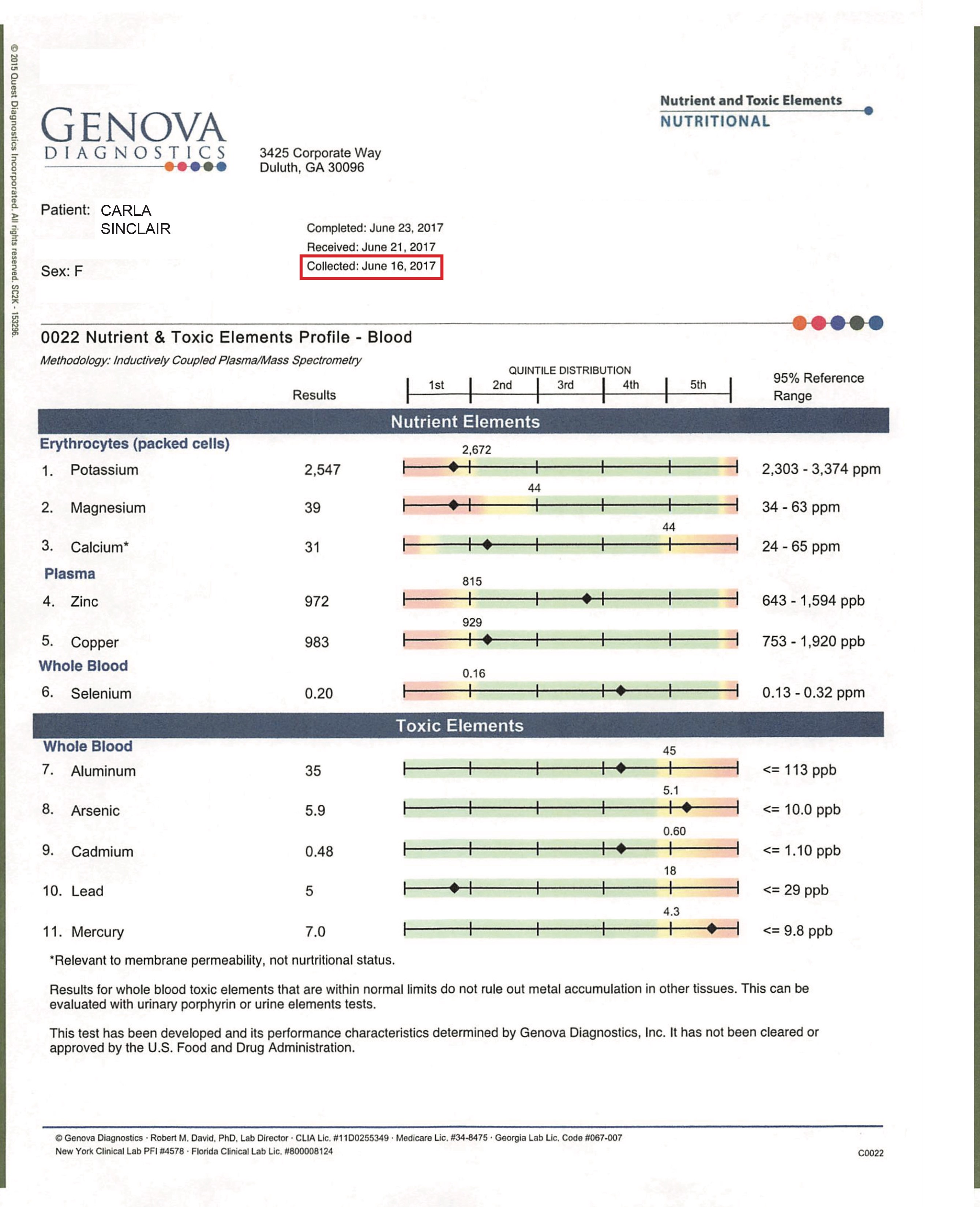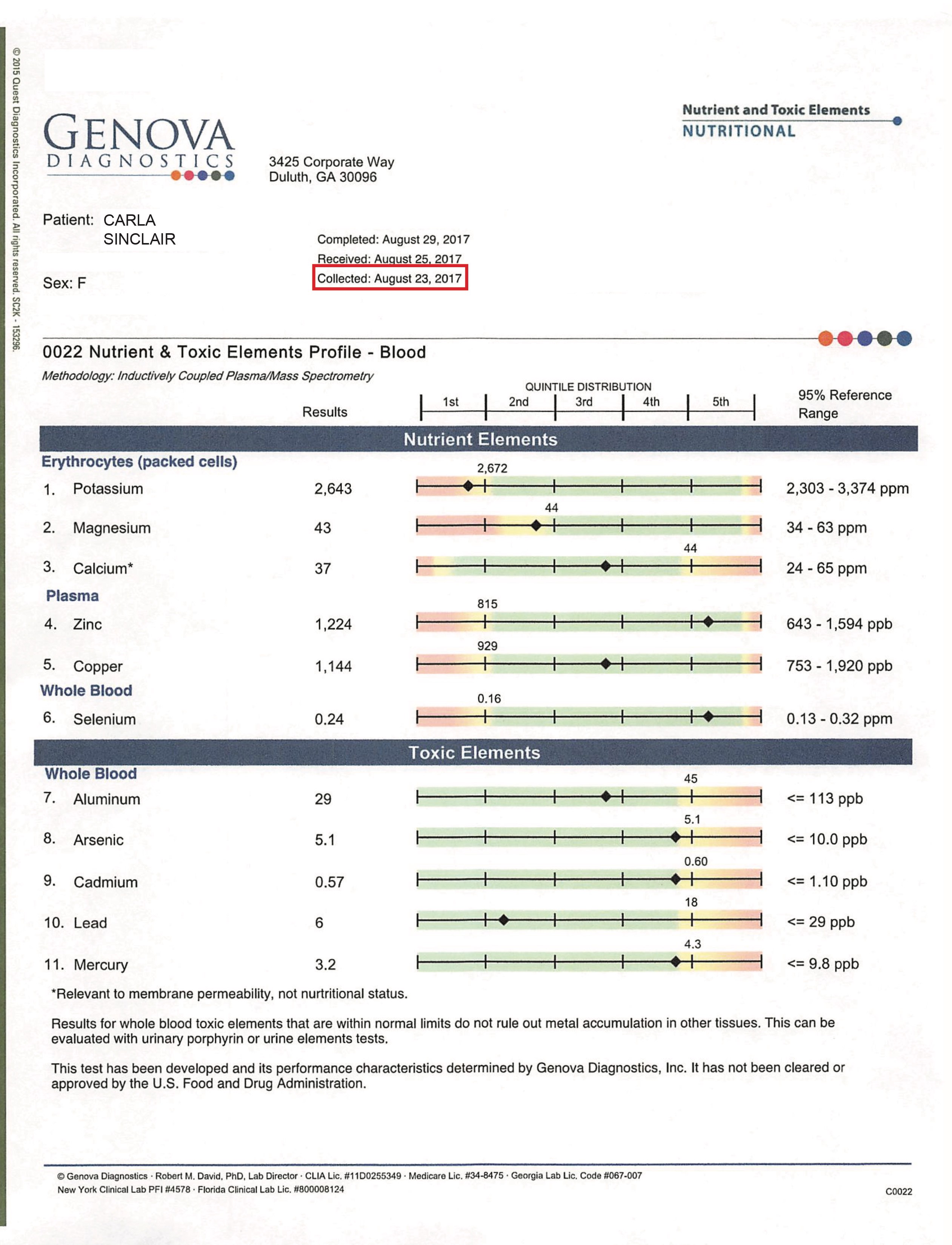My chronic insomnia was apparently caused by some of my healthiest habits. Here?s what I learned about detoxing, with help from my doctor.
 Photo by jarmoluk via Pixabay
Photo by jarmoluk via Pixabay
When my doctor suggested that I take a test to check for heavy metals in my body, I thought it was a bit radical.
?Heavy metals?? I asked.
I only knew of one person ? a friend of a friend ? who had been tested for heavy metals, and she was having trouble with her memory and fine motor skills.
I was in the doctor?s office for chronic insomnia, not neurological problems.
My doctor explained that it?s common for us to have high levels of at least one type of heavy metal in our body, and it was worth doing the test for many reasons.
?But can it help my insomnia??
Why I Tested for Heavy Metals
My doctor explained that chronic exposure to certain metals could potentially cause insomnia, and they could also be causing some of my other annoying issues. Excessive zinc could be causing my fatigue, high levels of copper could be giving me my slight anxieties, and metals such as cadmium could be the reason for my frequent brain fog (symptoms that I blamed on my chronic insomnia).
But more importantly, high levels of heavy metals could cause more serious issues with symptoms that might not be obvious until it?s too late. For instance, high levels of cadmium could lead to Parkinson?s, Alzheimer?s and Huntington?s diseases. Arsenic toxicity could lead to various cancers. Chronic exposure to mercury (methylmercury) could cause neurological disorders that impair vision, hearing, walking, and coordination.
With more heavy metals in our food and environment than ever before, my doctor ? an M.D. ? is a big proponent of testing for them, especially since (if levels are high) there are simple ways to bring them down.
I still wasn?t completely convinced that I needed to take a test that sounded, in my opinion, a little drastic.
But as far as my insomnia was concerned, I was running out of solutions. I?d tried everything to combat it: sleeping pills, herbal supplements, more exercise, acupuncture, a light box, hypnotism, cutting out electronics, and wearing orange goggles at night to block out blue light. Nothing worked for very long. Even the potential (as the doctor put it) that heavy metals could be the culprit of my insomnia made testing attractive.
So I nodded and said I was open to anything.
My Own Testing
We can check the levels of heavy metals in our bodies in a variety of ways, including a blood, stool, hair, or urine test. In my case, the doctor ran a simple blood test.
The blood panel was divided into two main sections: ?nutrient elements? and ?toxic elements.?
Under nutrient elements, the test included potassium, magnesium, calcium, zinc, copper, and selenium. Although high levels of these elements can cause health problems, these are metals that are beneficial to our health in small doses.
The toxic elements in the test included aluminum, arsenic, cadmium, lead, and mercury. These are metals with no known health benefits?but they can have many devastating effects.
How to read the results
Before telling you what my results were, let me quickly explain how to read the results.
The lab that my doctor uses provided an easy-to-read bar graph in addition to the more technical language.
Each element is charted on a horizontal bar that is divided into color-coded zones: green, yellow, and red. As your instincts might tell you, green signifies the normal range, yellow means you are moving in the wrong direction (or in the right direction, if your levels were previously higher), and red lands you, to put it bluntly, in the danger zone.
In the nutrient elements section (e.g., potassium, magnesium and calcium), your result can fall into a red zone on either end of the bar ? red on the left end means you are deficient in the element, while red on the right end of the bar means you have an excess amount of the element. You want to fall somewhere in the middle ? the green section ? of the bar.
With the toxic elements, however, red is only on the right side of the bar. You can?t be deficient in aluminum, arsenic, cadmium, lead, or mercury! Any amount of these elements is unwanted. So the goal here is to have the result showing up as far to the left of the bar as possible.
My Surprising Results

When my test results came in two weeks later, the findings were not what I expected.
What surprised me most was that my mercury level was through the roof! The diamond-shaped result marker was sitting entirely in the red zone.
Mercury is highly toxic, and, according to the EPA, it?s a neurotoxin that can cause all sorts of neurological disorders, including loss of vision and problems with speech, hearing, walking, and other motor skills. To say I was nervous is an understatement.
Before I even met with my doctor to talk about the results, she emailed me and said, ?Cut out all tuna.? (I have more to share with you about mercury and fish below.)
Almost as surprising as the excessive mercury level was my high level of arsenic.
Arsenic!
On the arsenic graph, my diamond marker was wedged between the yellow and red zone. It was not as high as mercury was, but nearly as shocking because I had no idea that arsenic was something people had to worry about ? unless someone was trying to intentionally poison them.
I soon learned that chronic exposure to arsenic has been confirmed to be carcinogenic and can lead to skin, lung and bladder cancer. It?s also associated with liver and prostate cancer, as well as diabetes, neurological and cardiac disorders, and mood disorders. The fact that arsenic toxicity could also lead to insomnia and anxiety now seemed like a minor issue.
My doctor had a good idea of where the arsenic was coming from ? more on that below.
The rest of the test looked okay, but not great. My aluminum and cadmium levels were ?borderline,? according to my doctor, with the results falling in the last quarter of the green zone. The only toxic element that was comfortably low was lead.
As far as the nutrient levels go, everything fell into the green range except potassium and magnesium, which were slightly deficient. Nothing to panic about ? the doctor simply recommended supplements to boost these levels.
What caused my mercury toxicity
When I went in to discuss the results with my doctor, the first thing she asked about was fish in my diet. I told her that I ate Japanese food ? mostly sushi ? a few times a week. It?s my favorite cuisine, and I happen to live in a part of town that has at least a dozen Japanese restaurants within walking distance.
I knew where she was headed ? some fish have high levels of mercury.
In fact, although mercury exposure can come from polluted air and water, as well as amalgam fillings in our teeth, up to 90% of mercury accumulated in the body comes from eating certain types of fish and shellfish.
I had known that eating too much albacore tuna could be toxic ? it?s one of the foods I had cut out of my diet when I was pregnant with both of my daughters ? but I didn?t think eating it a few times a week post-pregnancy would be a big deal.
Yet, I?ve since found out that, according to the EPA, methylmercury (a ?powerful neurotoxin?) from eating fish and shellfish accumulates in our bodies slowly. If, on the rare occasion, you have it three times in one week, it shouldn?t be a big deal. But consume it three or more times a week over the course of many years, and you could have a problem. By the time we notice symptoms, our levels could be dangerously high.
This doesn?t mean we should avoid fish altogether. Fish and shellfish are an important food in many people?s diets, with essential nutrients and omega-3 fatty acids that can help maintain a healthy heart. We just have to be aware of which fish are safe to eat up to twice a week, and which fish have such high mercury levels that we should try to completely avoid them. The FDA has a chart that helps us figure this out.
Since my local tap water (Los Angeles Department of Water and Power) is considered to be safe, and I don?t have any dental fillings, fish and shellfish seemed to be the main cause of my toxic mercury level.
What caused my toxic level of arsenic
The doctor surprised me yet again when she said that all of the sushi I ate could also be contributing to my high level of arsenic ? not from the fish, but from the rice.
For years, rice was a huge portion of my diet.
Not only had I eaten a fair amount of rice from my weekly Japanese food consumption, I had also been avoiding gluten for years (only because others in my family were gluten intolerant, not because I was). Most gluten-free products are made with rice flour.
To add insult to injury, I was studying to get a sake advisor certificate (which I received, thank you very much), and frequently sampled sake for ?research? (heh heh). Of course, sake is rice-based.
I?ve since learned that millions of people are exposed to arsenic through polluted air, water and soil, and, according to the FDA, we are exposed to arsenic through rice more than any other food. Rice is a natural accumulator of arsenic?the plant uses silica from the soil for its structure. But silica and arsenic are chemically similar, so the rice plant also takes up arsenic often found in water.
Since my drinking water isn?t known to have high levels of heavy metals, it seems probable that my high arsenic level was related to my heavy consumption of rice and rice products.
What I Did To Bring My Mercury and Arsenic Levels Down
My doctor put me on a simple detox program that lasted for six months.
Her first instruction was an obvious one: cut out all fish and shellfish, as well as rice and rice products.
I didn?t have to become rice and fish-free forever. But the immediate goal was to bring my levels into the healthy range first. Then I could slowly add rice and fish (excluding fish with the highest mercury levels) back into my diet?at smaller amounts than I was eating before.
During this detox period, I replaced rice and rice products with potatoes and products made with potato flour.
My doctor also put me on a detox regimen of chlorella-cilantro, which comes in liquid form, along with the amino acid N-acetyl cysteine (NAC), which promotes detoxification. Here were the instructions:
- Start with 3 drops of chlorella-cilantro in an 8-ounce glass of water, twice a day, one hour before meals. (The brand I took was called NDF.)
- Increase each dose by 6 drops every other day until the dose reaches 52 drops twice a day.
- Take 1800mg of NAC (N-acetyl cysteine) per day.
- Squeeze lemon into your water throughout the day, and make sure to stay hydrated.
My results when I tested again were better? and worse.

Two months later, I had another blood test to see if my toxic metal levels had dropped.
To my relief, the detox was working! Both the mercury and arsenic levels had dropped into the green zone ? though barely. They were both borderline, each with the right point of the diamond marker poking into the yellow caution zone. Still, green is green, and it was amazing to see that such a simple detox regimen really worked.
The surprise, however, was my cadmium level. It wasn?t great before, but in the first test it was closer to the third quarter mark of the green range. Now it was right where the mercury and arsenic and had moved ? butting up against the yellow caution zone!
?Have you started smoking?? the doctor asked. Exposure to cigarette smoke is one of the main causes of toxic cadmium levels in the body.
I told her I hadn?t even been around other people who smoked!
We then talked about foods that contain cadmium, and lo and behold, potatoes are one of the cadmium-contaminated foods (along with shellfish, wheat, and certain other vegetables), and can raise levels of cadmium in our bodies when eaten in excessive amounts.
I had been eating more potatoes than ever before, to replace both rice and wheat. Now I wondered if this is what caused the uptick in my cadmium level.
The doctor said it was hard to know for sure. Our levels do fluctuate, and the difference in cadmium levels wasn?t so great as to make a solid assumption.
I followed the detox plan for six months. Then I weaned myself off of the chlorella and cilantro drops by cutting the dose in half every three days.
My doctor suggested I retest again in a year, rather than right away, since I was paying out of pocket. She was confident that my levels were safe enough.
A Year Later? And Another Round of (Stronger!) Detox
I followed the doctor?s orders and took another heavy metal test exactly one year later. This was late August. To save money, this time we only tested for the toxic elements (and not the nutrient elements). But before I go on, let me back up to eight weeks earlier.
In early July, I traveled to Tokyo for five weeks (a work-and-vacation combo trip). My doctor had given me a toxic metal preventative plan to follow while I was in Japan:
1. Take just 6 drops of chlorella-cilantro (NDF) every morning.
2. Take 900mg of NAC daily.
3. Drink plenty of lemon water throughout the day.
4. Keep my fish and rice intake down to 1?2 times per week.
Sounds simple enough, and taking the NDF drops and NAC pill was simple. But unfortunately, I had a hard time avoiding, er, resisting, rice and fish. In fact, I had at least a little of each nearly every day. I figured the light detox I was doing would keep the toxins at bay.
I was wrong.
Fast forward to August. The results from my latest (third) blood test were disappointing, but not surprising. My mercury and arsenic levels had both moved into the yellow-red zone. They weren?t completely in the red like they were on my first test results, but they were bad enough to warrant another detox.
And to rub salt (or metal) into the wound, my aluminum level, which had been near the (green) center of the bar graph on my second test, jumped way to the right, so that it was butting against the yellow caution sector. I immediately thought of the cheap aluminum pans in the kitchen of the Airbnb I had stayed in.
This time, my doctor prescribed a slightly stronger detox plan.
Instead of chlorella-cilantro drops, she put me on a supplement called CheleX by Xymogen (only available through a health practitioner), which, among other ingredients, contains chlorella, NAC, allicin (a garlic extract), and Calcium Disodium EDTA ? a chemical that binds itself to metals and then passes out of the body through urine. Here were the new instructions:
1. Take 1 CheleX pill twice a day, for one week, with meals.
2. After one week, increase each dose to 2 CheleX pills.
3. Take 900mg of NAC per day.
4. Like before, drink plenty of water throughout the day. This time, adding lemon is optional.
5. Sweat hard by sitting in a sauna for 60 minutes every week, which can be broken up into 30 minutes twice a week, or 20 minutes three times a week. If a sauna isn?t possible, take hot baths. (Fortunately, my gym has a sauna.) Exercise, although important for many reasons, doesn?t count for this step.
The doctor told told me to come back in three months to retest. If my levels are back in the safe range, I can stop the detox. If my levels are still too high, I will continue the detox for another three months, and then retest again. Either way, she wants me to vigilantly take precautions to help prevent another buildup of heavy metals.
Keeping Heavy Metal Levels in the Safe Range
Although we can?t completely control our heavy metal intake, we can do things to help reduce our absorption of them. The doctor gave me a few suggestions on how to do this:
- Eat a more varied diet ? I tend to eat the same foods every day because, with my busy schedule, it?s easier to have a meal routine that doesn?t take much thought. But I should rotate my carbs between wheat, potatoes, quinoa, rice, and other grains ? and vary my diet in every other category as well. Changing up the food in my diet gives me less of a chance to consume a concentrated amount of heavy metals.
- Avoid unfiltered tap water whenever possible.
- Avoid second-hand cigarette smoke (and of course, don?t smoke cigarettes yourself).
- Keep fish intake down to 1?2 times a week, and stick to fish with lower mercury levels.
- Reduce the arsenic in rice before eating it. To do this, thoroughly rinse the rice while it?s raw. Then cook 1 cup of rice in 6 cups of water (rather than the usual 2-ish cups). Cover the pot while it?s cooking (the more water that stays in the pot, the better). When the rice is fully cooked, strain it. Preparing rice this way can reduce arsenic by up to 45%. (This method of arsenic removal works best with long-grain and basmati rice.)
The End of Insomnia?and a New Testing Routine
Towards the end of the first detox I did, my insomnia started to subside. Although still not perfect, I?m now getting 6?7 hours of sleep, rather than the dreaded 4?6 hours. Miraculously, it didn?t get worse when my mercury and arsenic levels rose again.
It?s difficult to make a direct link between cause and effect. I don?t know for certain if my improved sleep is from the metal detox or from some new supplements I started around the same time. I was desperate and trying anything I could.
My brain fog and anxieties also subsided, but again, is this because I?m sleeping better, or because I reduced the heavy metals?
What I do know is that I had dangerous levels of mercury and arsenic in my body, and when I detoxed and checked again, they had dropped into the normal range. Then, when I went off the wagon in Japan and gorged myself on food that is known to contain mercury and arsenic, my levels went up again.
Having high levels of toxic metals can have detrimental consequences on our health, but fortunately, if we catch them early enough, we can bring them down to safer levels fairly easily. I now consider checking and maintaining heavy metal levels to be part of my regular health routine.


